Creative Lighting Solutions for Kitchen Islands

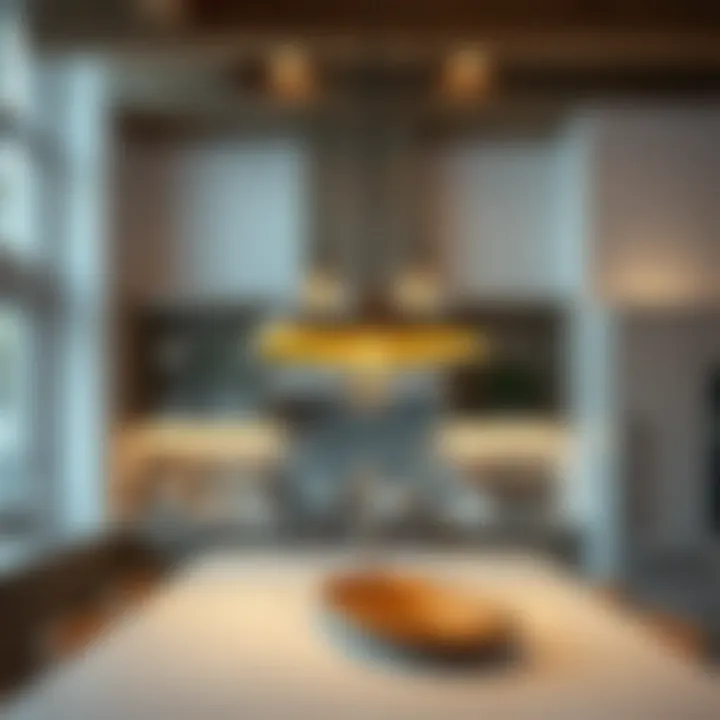
Intro
In the heart of any home, the kitchen serves not only as a place for cooking but also as a gathering point for family and friends. The kitchen island is often the centerpiece, a multifunctional space where meals are prepared, conversations flow, and memories are made. Thus, lighting becomes a critical component, influencing both the atmosphere and practicality of the space.
Lighting in this area can do wonders, setting the mood while also aiding in visibility for various tasks. With so many styles and schemes available, choosing the right lighting can feel like finding a needle in a haystack. However, by understanding the different options, homeowners can select lighting that aligns with their aesthetic preferences and functional needs.
Design Inspiration
Trending Styles
Designing the right lighting for your kitchen island involves staying up to date with current trends. Many homeowners now lean towards statement pieces that reflect their unique style while maintaining practicality. Popular options include:
- Industrial Pendant Lights: These fixtures are often characterized by metal finishes and minimalist designs, perfect for a modern, urban kitchen.
- Wide-Scale Chandeliers: Bringing an element of sophistication, large chandeliers become the focal points, blending elegance with ambiance.
- Rope or String Lights: Infusing a touch of whimsy, these simple yet charming lights can create a cozy atmosphere, suitable for relaxed settings.
- Under-Cabinet and Recessed Lighting: For a clean, streamlined look, built-in lighting provides subtle warmth without overwhelming the space.
Each of these styles presents a unique opportunity to express design intentions while maintaining functionality. Choosing a style should align with overall kitchen decor, ensuring a cohesive look.
Color Palettes
Color plays a significant role in how lighting affects a space. When selecting fixtures for your kitchen island, consider these guidelines:
- Warm Whites for Comfort: These tones create an inviting feel, pairing well with rustic and traditional kitchens.
- Cool Whites for Modern Clarity: If your kitchen features sleek design elements and cool tones, opt for crisp white lights to enhance that aesthetic.
- Accent Colors: Incorporate fixtures with colored glass or shades that tie into other kitchen elements, such as counter tops or cabinet hues. This touch of creativity can make your island truly stand out.
By merging trending styles with thoughtful color choices, lighting can become a stunning anchor in your kitchen, illuminating your space while harmonizing with your home’s design.
Practical Tips
When embarking on your lighting project, it’s essential to keep practicalities in mind to ensure a successful and enjoyable design process.
Maintenance & Care
Lighting systems require proper care to maintain their efficiency:
- Regular Cleaning: Dust and grime can dim your fixtures over time. Make it a habit to clean pendant lamps and recessed lighting periodically to keep them bright.
- Check Bulbs: Regularly ensuring that bulbs are functioning will save you from the annoyance of dim or non-working lights, keeping your island well-lit.
Budgeting & Planning
Before diving headfirst into purchasing new fixtures, a well-thought-out budget can help you stay on track:
- Price Range: It’s crucial to establish what you’re willing to spend. Lighting can range considerably, so knowing your limit can help narrow choices.
- Install Costs: Don’t overlook installation costs if you’re unable to tackle it yourself. Sometimes hiring a professional can save you time and headaches later on.
By addressing both the aesthetic and functional aspects of lighting for kitchen islands, you can create a beautiful and practical centerpiece that enhances your cooking and entertaining experiences. This thoughtful approach ensures that your kitchen is not only a hub of activity but also a space that reflects your personal style and warmth.
Understanding the Role of Lighting in Kitchen Design
Lighting is more than just a necessity in kitchen design; it's a fundamental element that can make or break the feel of the space. It illuminates not just surfaces and areas but also enhances the overall aesthetic appeal and functionality of the kitchen. For homeowners and design enthusiasts alike, understanding the role of lighting can be a game-changer when planning out a kitchen island or the kitchen at large.
Creating the right ambiance can significantly impact how the kitchen is used, from brightening up early mornings to setting a softer tone for evening gatherings. This becomes particularly pertinent in an open-plan layout where the kitchen merges seamlessly with living spaces. A well-placed light fixture can create zones that invite social interaction while retaining clarity in work areas. For instance, using pendant lights above the island can create a focal point that draws people in, making the kitchen not just a cooking space but a hub for connection.
In addition to ambiance, it's crucial to factor in functional versus aesthetic lighting. Lighting does not just serve to beautify the space, although that’s a vital part of it. Different types of lighting serve distinct purposes; task lighting is direly important for food preparation areas, while ambient lighting fills the room with soft, inviting warmth. Making this distinction is key. Ideally, a successful kitchen will balance both functional and decorative aspects of lighting, ensuring that each corner serves its purpose, no matter the time of day.
"A well-lit kitchen is like a well-oiled machine: everything functions better when it’s illuminated correctly."
Considering these elements is not merely about choosing the right fixtures; it involves understanding how they interact with color schemes, textures, and even the natural light that comes pouring in through windows. This holistic approach can lead to options that seamlessly blend functionality with style.
Closure
In summary, the role of lighting in kitchen design is multi-faceted. It is a key player in crafting a welcoming ambiance, enriching the aesthetic appeal, and ensuring that the workspace is practical and comfortable. Lighting must not be an afterthought but treated as an integral part of the design process, making the kitchen both a functional workspace and a social haven for family and friends.
Types of Lighting for Kitchen Islands
Lighting plays a significant role in shaping the kitchen's atmosphere, particularly around the kitchen island, which often serves as both a cooking space and a social hub. Choosing the right types of lighting can elevate the kitchen's functionality and aesthetic appeal, allowing homeowners to create a beautifully lit environment that suits their activities. Dining, cooking, studying, or gathering for conversations—different lighting options can cater to various needs while enhancing the space's overall look.
Pendant Lighting
Pendant lights hang from the ceiling and can create a striking focal point above the kitchen island. They come in various styles and sizes, appealing to different design sensibilities.
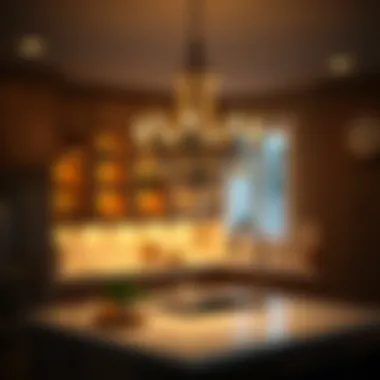
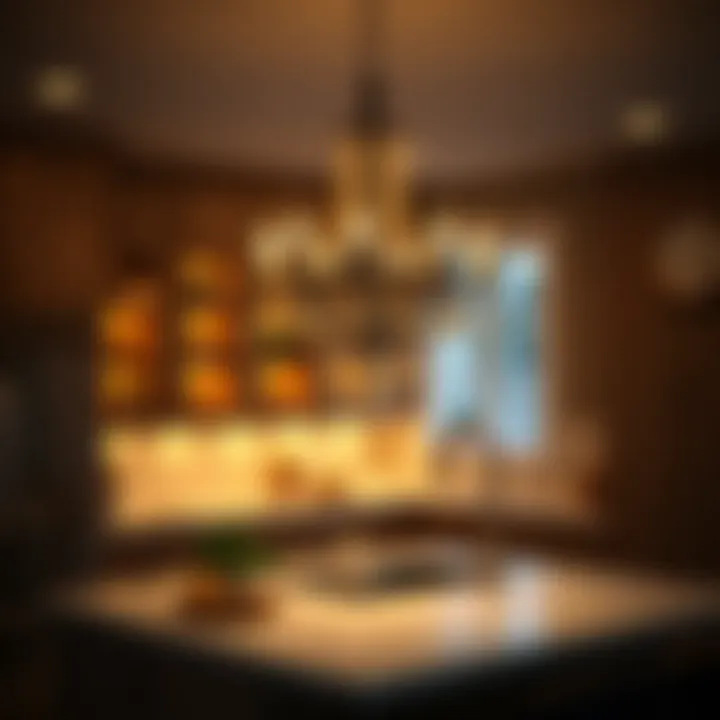
Choosing the Right Size
Selecting the appropriate size of pendant lighting is crucial. Not only should the fixture fit proportionally with the island's dimensions, but it should also have enough presence to make a statement without overwhelming the space. A common guideline suggests that the diameter of the pendant should range between a third to a half of the island’s width. For example, if your island is wide enough at 36 inches, opting for pendant lights with a diameter of 12 to 18 inches works well.
An essential characteristic of choosing the right size is ensuring proper distance from surfaces. Typically, the bottom of the pendant should hang around 30 to 36 inches above the countertop. This height allows for safe clearance without blocking views.
Advantages of this approach include enhancing visibility while preparing meals or engaging in social activities, creating a well-lit area. However, if they are too small, the overall effect diminishes, leading to a confused and cluttered look.
Style Variations
Pendant lights also offer an array of style variations, suitable for different kitchen aesthetics. From industrial to rustic, modern to vintage, the styles range widely, allowing for personalization. A unique feature is their ability to complement other design elements in the kitchen, making it feel cohesive.
Opting for a style that resonates with your overall kitchen design leads to a beneficial part of the lighting ambiance. For instance, a sleek metal finish might suit a contemporary kitchen, while a hand-blown glass variant could enhance a farmhouse ambiance. This mix adds depth and character, showing off the owner’s personality.
However, with so much variety comes a chance for misalignment. Choosing a style that clashes with other elements may lead to disarray, emphasizing the need for careful consideration.
Chandeliers
Chandeliers can add drama and elegance, creating a luxurious ambiance for kitchen islands. These fixtures, with their bold designs, can transform a simple space into a sophisticated area of interest.
Design Considerations
When considering chandeliers, one must think about the overall design intent. It’s important to ensure that the chandelier selected aligns with other decor elements present in the space. Styles like crystal, metallic, or even wooden can influence the kitchen's mood significantly. A leading characteristic of chandeliers is their ability to act as a centerpiece, making them popular in homes aiming for a touch of class.
A unique benefit of chandeliers is their versatility in lighting. They can be fitted with adjustable bulbs or shades that fit the specific ambiance desired—whether it’s dim and cozy or bright and inviting.
Nevertheless, their installation can require special attention. If the chosen chandelier is too grand for the island, it can overshadow the area’s aesthetics, so striking a balance between size and style is key.
Height and Positioning
The height and positioning of a chandelier above a kitchen island are vital for maximizing its function and visual appeal. Generally, the fixture should hang between 30 to 34 inches above the countertop. This ensures ample light without obstructing vision.
A key feature of appropriate positioning is to center the chandelier over the island for a harmonious look. This symmetry also aids in balancing the light distribution across the surface. Ultimately, ensuring proper adjustments can lead to a cohesive, well-functioning space.
While these considerations work well, there’s always a risk of installations going wrong. The chandelier can feel out of place if not properly sized or spaced, diminishing its splendor.
Recessed Lighting
Recessed lighting is discreet and serves to provide functional illumination across various working spaces. Thoughtfully placed recessed lights can enhance visibility without drawing attention to themselves, making them excellent choices for kitchen islands.
Installation Tips
When it comes to installation, making sure the recessed lights are placed at appropriate intervals is crucial for even light distribution. A common guideline is to space the lights about 4 to 6 feet apart, depending on the brightness desired and the lumens output.
A unique feature of recessed lights is their ability to blend seamlessly with the ceiling. This makes them a clean option for space-conscious kitchens. Additionally, their versatility allows for the use of dimmers, providing further adaptability to light levels.
On the downside, improper installation can lead to dark spots or overly bright areas, failing to serve its purpose effectively.
Best Practices for Placement
Placement involves understanding specific activities conducted around the island. For cooking or food prep, aligning the lights directly over those areas maximizes functionality. This highlights the importance of considering the tasks at hand when planning the layout.
Additionally, taking kitchen height into account can enhance the effectiveness of these lights. As a rule of thumb, insurance should be made to steer clear of having too many lights too close together, which can lead to glare. The goal is to create a balanced distribution of light that complements the kitchen's operability.
While highly practical, experiencing poor placement can result in shadows and excess brightness, which may distort the area’s appearance.
Under-Cabinet Lighting
Under-cabinet lighting plays an indispensable role in providing functional illumination for kitchen tasks. It's particularly useful, as it casts light directly on countertops, improving visibility for cooking or food prep.
Purpose and Functionality
The primary purpose of under-cabinet lighting is enhancing task efficiency. By illuminating surfaces where food is prepared, it maximizes usability, ensuring that homeowners can see what they are doing without straining. You can utilize various lighting fixtures here, from LED strips to puck lights, catering to different preferences and needs.
Another aspect of its function is its ability to create layered lighting in the kitchen. When paired with overhead fixtures, it gives a well-rounded effect that enhances atmosphere.
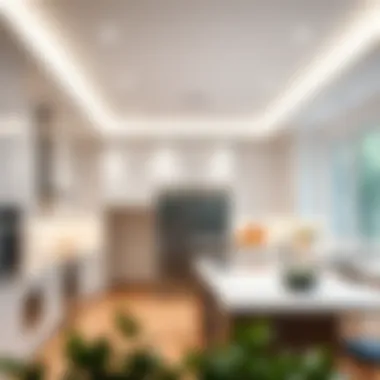
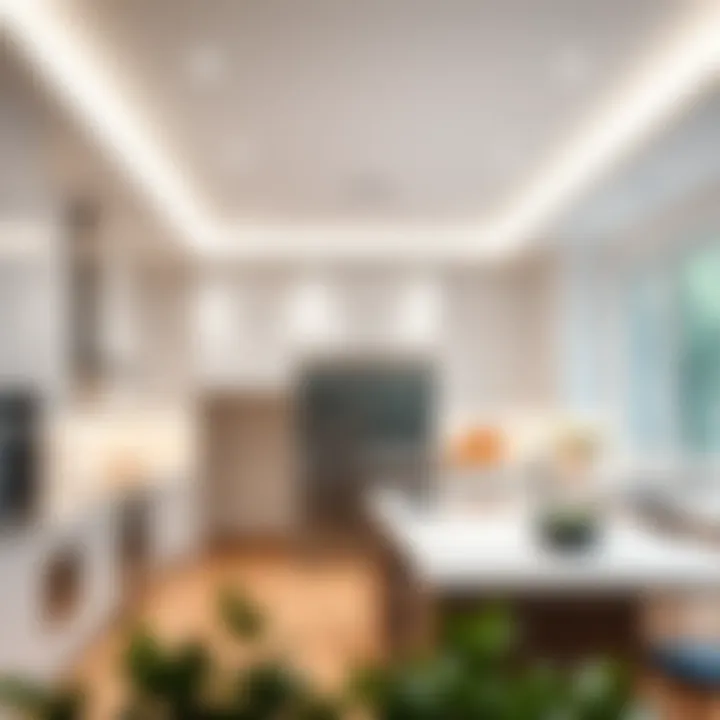
However, it does have some downsides; if placed improperly, it might create shadowy spots—which dampens its intended function.
Types of Fixtures
The types of fixtures typically considered for under-cabinet lighting include LED tape lights, puck lights, and rigid linear fixtures. Each type has its own set of benefits and can cater to different kitchen layouts. For example, LED tape lights offer flexibility and ease of installation, while puck lights provide targeted illumination.
A beneficial aspect of these fixtures is their low energy consumption. Many LED options use less power while providing ample brightness, making them an energy-efficient choice.
However, when too many types are mixed, they can result in an inconsistent look—hence careful selection is important.
Brightness and Color Temperature
The role of brightness and color temperature in kitchen lighting design cannot be overstated. These two components significantly influence not only how well you can complete kitchen tasks but also the overall vibe of the space. When determining the right lighting for your kitchen island, one should think not just about illumination but the color it emits; light can create various moods and enhance the cooking and entertaining experiences. Getting this balance right can be the difference between a functional kitchen and one that feels inviting and aesthetically pleasing.
Understanding Lumens
Lumens measure the total amount of visible light emitted by a source. Understanding lumens is key to achieving the correct brightness for your kitchen island, as too few can make your prep work cumbersome, while too many can cause glare, making the space uncomfortable. Generally, a work area like a kitchen island can benefit from brighter lights ranging from 300 to 600 lumens per square foot.
It's important to assess the specific tasks that will be performed in this area. For instance, if you're using the island primarily for food preparation, you might aim for brighter light levels. On the other hand, if the island serves as a gathering space for casual meals or socializing, softer, more diffused lighting could create a warmer atmosphere. You have to keep in mind both your functional lighting needs and personal preferences when considering lumens.
Color Temperature Explained
Color temperature, often measured in Kelvin (K), refers to the hue of a particular light source. Warm white light, typically below 3000K, creates a cozy and comfortable space, while cool white light, ranging from 4000K to 5000K, provides a more energizing and focused ambience.
Warm versus Cool Lighting
Warm lighting tends to produce a yellowish hue, akin to candlelight. This type of light is often flattering to skin tones and can make a kitchen feel more inviting. People gravitate toward warm lighting when they want to create a homey feel, especially in spaces where they entertain or relax. It pairs well with wooden elements and soft furnishings, enhancing the overall aesthetic of a rustic or traditional kitchen.
Cool lighting, however, shines a bluish shade that resembles daylight. This is a favorable choice for contemporary spaces as it promotes alertness and productivity. Kitchen islands, in particular, could benefit from cool lighting when preparing food or working on intricate tasks, enhancing visibility and detail. The downside is that it can feel sterile or clinical if overused.
Setting the Mood
The way your kitchen feels can greatly influence your culinary creativity and family interactions. Soft lighting creates a comfortable environment, inviting you to linger longer, whether you're sipping coffee at the island or chopping veggies for dinner. Different light sources can drastically change the level of intimacy or liveliness in the room.
Choosing varied lighting schemes allows for mood adjustments throughout the day. One moment, bright lights support baking sessions, and the next, dimmed lights can set the stage for a cozy gathering over wine and cheese. It’s like having a blank canvas that changes colors based on your intent. The unique feature about manipulating light in this way is its power to transform a mundane kitchen into a dynamic space that reflects your daily lifestyle.
Having an understanding of brightness and color temperature will go a long way in ensuring that the kitchen island serves its purpose to the fullest, while also being a jewel pendant in your culinary crown.
Designing a Cohesive Lighting Plan
Designing a cohesive lighting plan is not merely an artistic endeavor; it's an essential process that marries functionality with style in your kitchen space. Lighting choice can dramatically influence the mood and efficiency of tasks performed on a kitchen island. When the lighting seamlessly integrates with the overall design of the kitchen, it transforms the area into a welcoming and practical hub.
One of the key aspects to remember is that lighting should not compete with other elements in the kitchen, but rather work in harmony with them. This can interpret itself through matching fixtures, similar finishes, and colors that connect lighting sources throughout the space. Cohesion, therefore, is more than just matching—it's about creating a flow that feels intuitive and thoughtful.
When carefully planned, cohesive lighting enhances the functionality of the space. For instance, focusing light directly on areas of the island where food prep happens can make cooking more efficient, providing an effective combination of style and utility.
Consistent Styles and Finishes
Maintaining consistent styles and finishes in your lighting selections is crucial for achieving a polished and sophisticated look. Whether you prefer a contemporary vibe with sleek metals or a rustic charm using warm wooden accents, selecting fixtures that support the overall decor of your kitchen not only showcases personal taste but also creates a unified appearance.
Imagine a kitchen with stainless-steel appliances, wood cabinetry, and copper accents. Incorporating these elements into the lighting fixtures—like a brushed nickel pendant over the island—can bring a harmonious feel to the room. This attention to detail helps unify various features, making the kitchen more visually appealing.
Layering Light for Effectiveness
Layering light involves using different sources and types of lighting to create a dynamic yet functional environment. This brings your kitchen island to life in more ways than one. By combining various types, such as ambient, task, and accent lights, you can achieve brightness when needed but also set a relaxing mood when entertaining guests.
Combining Different Types of Lighting
Combining different types of lighting is a tried-and-true method for enhancing the kitchen island. For example, using recessed lighting in tandem with stylish pendant lights creates a balance between general illumination and targeted brightness. This approach allows you to tailor the lighting according to the time of day or specific activities.
One exciting feature of combining various lighting is the versatility it provides. You can switch from a bright, bustling atmosphere when cooking to a softer glow for gatherings. However, one must be mindful of achieving that balance; too many competing lights can create a jarring effect.
Creating Depth and Interest
Creating depth and interest is all about layering different light sources at varying heights and intensities. This perception of depth transforms a flat space into an engaging and multi-dimensional environment. It invites movement into the kitchen, drawing the eye to different elements, whether it be a beautifully crafted backsplash or intricate cabinetry.


By using a mix of under-cabinet lighting and strategically placed fixtures overhead, you can highlight the textures and colors that make your kitchen unique. It's a way of showcasing your creativity and making an ordinary kitchen feel extraordinary. That being said, overdoing it can lead to a chaotic vibe; careful selection and placement are vital for that ideal layered effect.
Thoughtful design choices can turn your kitchen into a stunning showcase of light and functionality, ensuring every meal and gathering is a memorable one.
Energy Efficiency in Kitchen Lighting
In the current era, being conscious about energy consumption is not just a trend but a necessity. In the realm of kitchen design, energy efficiency plays a critical role in both sustainability and cost-effectiveness. Homeowners are more informed than ever about their energy usage, and lighting significantly contributes to any kitchen’s overall energy expenditure. Choosing the right lighting not only reduces electricity bills but also supports a healthier environment. In this section, we’ll explore various aspects of energy-efficient lighting options, so you can illuminate your kitchen island wisely and sustainably.
Selecting Energy-Efficient Bulbs
When selecting bulbs for your kitchen island, energy-efficient options are paramount. LED bulbs have quickly gained the spotlight due to their remarkable efficiency. These bulbs use about 75% less energy than traditional incandescent bulbs, offering a longer lifespan without sacrificing brightness. Additionally, compact fluorescent lamps (CFLs) are another suitable option, using approximately 70% less energy than traditional choices. They produce less heat as well, which contributes to their cost-saving feature.
When shopping for bulbs, look for the ENERGY STAR certification. This label indicates that the bulb meets strict efficiency guidelines set by the U.S. Environmental Protection Agency. Their longevity and performance can significantly lower your energy consumption, making them a wise choice for those intentional about reducing their carbon footprint.
Using Smart Technology
Technological advancements are reshaping the way we approach lighting in our homes. Smart technology provides innovative solutions for managing energy consumption effectively. With smart lighting systems, you can control lighting remotely, set schedules, or even adjust brightness and color tones all from your smartphone. This level of control not only enhances convenience but also promotes energy efficiency.
Smart Dimmers and Timers
Among the smart options, dimmers and timers stand out as particularly beneficial tools. Installing smart dimmers enables users to tweak light intensity to match various activities, whether it’s meal prepping or hosting a dinner party. This adaptability reduces energy waste by ensuring that lights aren’t brighter than necessary. Moreover, timers can automatically turn lights on or off according to your routine, which prevents leaving lights on when they aren’t needed.
The unique feature of dimmers is their ability to help set different moods and aesthetics in a kitchen while simultaneously saving energy when the full brightness isn't needed. Although they might come with a slightly higher initial cost, the energy savings in the long run make them a wise investment.
Remote Control Options
Another exciting aspect of smart lighting is remote control options. These systems often allow homeowners to integrate their lighting with home automation platforms, like Google Home or Amazon Alexa. This technology doesn’t just make life easier; it also optimizes energy consumption.
Being able to control lighting from anywhere means you can ensure lights are off after leaving, removing the worry of accidental energy waste. With features like scheduling and notifications, you can tailor your lighting usage to your lifestyle. While remote controls do add layers of complexity to your setup, they ultimately help adjust light usage according to personal needs, making energy savings achievable.
"Investing in energy-efficient lighting not only saves money but significantly reduces environmental impact. It’s a win-win for the planet and your pocket!"
In summary, energy efficiency in kitchen lighting is about more than just choosing the right bulbs. It requires an understanding of how technology can enhance your existing setup, allowing you to make choices that are financially smart and environmentally friendly. By integrating energy-efficient bulbs and smart technology, you can illuminate your kitchen island in a way that aligns with modern values of sustainability.
Practical Considerations for Installation
When setting up innovative lighting for kitchen islands, practical considerations are crucial. It's not just about picking the most visually appealing fixtures. Installation involves understanding spatial dynamics and technical requirements. These aspects are what separate a well-designed kitchen from one that feels chaotic or unsuitable. A thoughtful approach can help create an inviting atmosphere while ensuring functionality and safety.
Height and Placement Logistics
Finding the right height for lighting fixtures above the kitchen island can be a bit of a balancing act. Too high, and the light may not adequately illuminate the space; too low, and it might feel obtrusive or risk being a bump hazard.
- Standard Height: Generally, pendant lights are hung about 30 to 36 inches above the countertop. This height ensures enough visibility without feeling overwhelming.
- Visual Balance: Consider the scale of the island. A large island might benefit from larger fixtures or multiple smaller ones, while a compact island may require single, streamlined pieces.
- Eye Level: It's wise to consider the average eye level of the users. Ensuring that light fixtures won’t obstruct views or create awkward shadows adds to both form and function.
- Multiple Layers: If the island serves various purposes, like prep work or casual meals, layering the lights can enhance usability. A mix of ambient light and task lighting can create a flexible environment.
By being mindful of placement logistics, you can create not only a beautiful kitchen but also a highly functional one.
Wiring and Electrical Requirements
Once you've settled on light placement and heights, it’s time to tackle the technical side: wiring and electrical requirements. This aspect may seem daunting, but it’s essential for ensuring effective and safe illumination.
- Electrical Load: Before installation, always assess your current electrical load. It's important too ensure that your household wiring can handle the additional load. Consulting a professional electrician might save you from future headaches.
- Circuit Considerations: For kitchen islands, placing lights on a dedicated circuit helps minimize any electrical interference with other appliances.
- Switch Locations: Think about convenience. If you're frequently reaching for a switch, make sure it’s in a spot that’s easy to access, perhaps near where people gather around the island. No one wants to be stumbling in the dark.
- Safety Standards: Compliance with local electrical codes is non-negotiable. This means using fixtures rated for moist areas, especially if your kitchen sees a lot of cooking or spills.
Incorporating these electrical considerations will give you peace of mind and ensure your beautiful lighting setup remains both stylish and safe.
"Good design is about making something that is well-crafted, functional, and beautiful—but it starts behind the scenes with careful planning."
By weighing these practical matters, homeowners can confidently proceed with their lighting installations, leading to a gorgeous, well-lit kitchen that enhances daily life.
The End: Tailoring Lighting to Your Kitchen Needs
Lighting in a kitchen is more than just a matter of visibility; it fundamentally shapes the atmosphere and functionality of the space. When it comes to kitchen islands, striking the right balance between our personal style preferences and practical considerations is key. Tailoring your lighting choices not only enhances the visual appeal but also serves various kitchen activities, from preparing meals to hosting friends during lively gatherings.
Personalization is a vital aspect of determining lighting for your island. Your kitchen should echo your style—a reflection of who you are. A sleek, modern pendant light may suit one homeowner’s minimalist aesthetic while an ornate chandelier may resonate more with someone who appreciates classic decor. Understanding these preferences guides the selection of fixtures that complement cabinet colors, countertops, and flooring.
Furthermore, we must acknowledge that functionality is just as essential as aesthetics. The lighting above your kitchen island must accommodate workflow needs. For example, brighter lighting is favorable for food preparation, but softer, warm lighting might be ideal for evening gatherings, where ambiance trumps intensity. Here are several key elements to ponder as you tailor your kitchen lighting:
- Task Lighting: It’s crucial for activities such as chopping vegetables or mixing dough.
- Ambient Lighting: Helps in creating an inviting atmosphere for social interactions.
- Accent Lighting: Allows you to highlight beautiful elements in your kitchen, such as decorative cabinets or artwork.
"The right lighting can turn a practical workspace into a warm and inviting environment."
Incorporating energy-efficient technologies and smart lighting systems can enhance functionality. Smart dimmers allow you to adjust brightness according to the occasion, ensuring that your lighting is both effective and economical. For instance, LED bulbs not only save energy but also come in various color temperatures, allowing you to adjust the mood easily.
To sum it all, when personal style meets functional requirements, you create a kitchen island space that truly feels tailored to your needs. The beauty lies in blending these elements seamlessly, ensuring that your kitchen isn't just a place for cooking, but a hub for family and friends.















